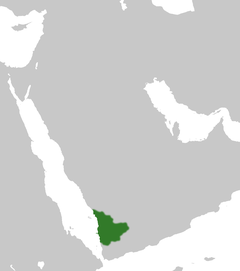 | |
| Date | The Kingdom of Saba in its later days |
|---|---|
| Location | Modern day Ethiopia and Eritrea |
The Sabean colonisation of Africa was a process of colonization by Sabeans that occurred in the Horn of Africa during the first millennium BC.[1]
One of the oldest colonisation process in history occurred around 1000 BC, the Sabeans of southern Arabia, with a civilization based on agriculture, began to colonize the highlands of northern Ethiopia and Eritrea.[2][3][4][5] The indigenous peoples with whom the Sabaeans came into contact were the ancestors of the contemporary Agaw people. The fusion of southern Arabian culture and Agaw culture resulted in a third culture which are today known as the Habesha people.[6]
The Sabean occupation and influence allowed for Ethiopia to develop several civilizations like D'mt but also the Kingdom of Aksum and left a very important mark in Ethiopian history and culture, a team of German archaeologists also recently concluded that all fundamental characteristics of Aksumite society derived from earlier populations in the Near East and South Arabia.[7] Cultural transmission from the Sabean region to the Horn of Africa extended beyond architecture and stone-masonry, reaching far into the sociopolitical, religious, and cultic spheres[8][9] The Sabean character of the pantheon is clearly evident in the worship of 'Almaqah, to whom, in addition to the Great Sabean Temple at Yeha,[10] four other sanctuaries are known. Some of these are accompanied by the building dedications of Sabean stonemasons and can be identified archaeologically.[11] Many other archaeological sites of this period in Ethiopia where some inscriptions have also been found which were executed in a Sabean-Himyaritic script, near Makalle, for example where a seated female figure was found with a South Arabian inscription on the pedestal which also makes reference to South Arabia.[12] Older inscriptions were found at Yeha, which some scholars identify with Ava, a city built by Sabean colonists, and which apparently fell into decay after the building of Aksum the "Sacred City of the Ethiopians."[13] Not only Yeha but also the ancient city of Aksum is considered by some scholars to have been founded by these Sabeans,[14] where old Sabaic inscriptions have also been found.[15]
While the Sabean influence in the Kingdom of Dʿmt is undeniable, recent scholarship suggests that this relationship was more nuanced than traditional colonial control. The evidence indicates a complex interaction characterized by cultural exchange, trade, and possibly migration, rather than direct political domination.
Firstly, the linguistic and scriptural similarities between Dʿmt and Sabaean inscriptions, as seen in the linguistic analysis of the Dʿmt inscriptions, indicate cultural and linguistic interactions, but not necessarily direct colonial imposition. The language of Dʿmt, while showing Sabaean influence, also evolved its unique characteristics, suggesting an active process of cultural assimilation and adaptation.
Secondly, the political structure of Dʿmt, as inferred from inscriptions and other historical records, points to a degree of autonomy. Dʿmt had its rulers and administrative systems, which, while influenced by Sabaean models, maintained distinct local features. This independence is a key aspect that differentiates the Sabean interaction with Dʿmt from a straightforward colonial relationship.
Moreover, the social composition of Dʿmt, as reflected in inscriptions that mention different groups within the society such as Sabeans, "Immigrants," Reds, and Blacks, indicates a heterogeneous society. This diversity further supports the idea of Dʿmt as a melting pot of cultures, where Sabaean influence was one among many.
Lastly, the religious practices in Dʿmt, with shared deities like Almaqah, illustrate religious connections with Saba. However, shared religious beliefs often spread through trade and cultural contacts and do not inherently imply a colonial relationship.
In conclusion, the relationship between Saba and the Kingdom of Dʿmt during the first millennium BC was marked by significant cultural and linguistic influences. However, the evidence supports a view of Dʿmt as a culturally rich and politically autonomous entity that engaged in dynamic interactions with Saba, shaping its unique identity in the Horn of Africa. [16]